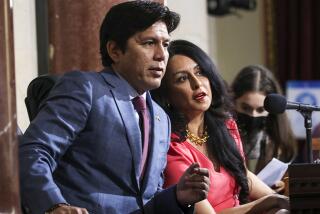Neighborhood Councils Put Their Stamp on City Issues
- Share via
SIMI VALLEY — When residents of this quiet city look east, past the sunburnt Santa Susanas toward the expanse of the San Fernando Valley, they know there’s more than just a row of hills that separates them.
Issues of representation in city government--contentious matters being raised by groups in Valley communities such as Tarzana and Chatsworth--are about as foreign to Simi Valley as shark fin soup.
For the record:
12:00 a.m. April 1, 1998 For the Record
Los Angeles Times Wednesday April 1, 1998 Valley Edition Metro Part B Page 9 Zones Desk 2 inches; 44 words Type of Material: Correction
Neighborhood councils--A story Monday incorrectly reported several details about a Simi Valley neighborhood council member. Norma Coony, a resident of Simi Valley for 10 years who believes the councils provide a valuable link between residents and city officials, is a member of Neighborhood Council No. 1.
Getting their leaders to listen, most say, has never been much of a problem. They have a power that goes beyond the ballot box: neighborhood councils.
“If you look at the quality of life here, it’s pretty high--and that is due in large part to the neighborhood councils,” said Bill Harris, chairman of Neighborhood Council No. 4.
“It’s a safety valve that makes sure that city government is there to serve us, the residents of Simi Valley.”
Since its incorporation in 1969, Simi Valley has relied on a system of councils to bridge the troublesome gap between the elected and the electorate, giving residents a role in shaping the city’s future.
A similar system is being studied by the Los Angeles Charter Reform Commission as a way to answer complaints at the core of San Fernando Valley secessionist campaigns that are threatening to rip the city apart.
Composed of 13-member executive boards that are appointed by the City Council after a careful review and interview process, Simi Valley’s four neighborhood councils are a reflection of the city’s diverse population. Everyone from marketing specialists to construction workers to retirees serve on the councils.
Although they have no real power other than to make recommendations, their opinions carry a lot of weight, city officials say. They’ve left an imprint on everything from the soon-to-be-built Wal-Mart shopping center to a proposed property maintenance ordinance that will come before the city next month.
“It was set up for the people to be a link between them and the city,” said City Manager Mike Sedell. “It gives us here in City Hall the kind of important input we need.”
As the county boomed in the years immediately after World War II, residents of Simi Valley were left seething with discontent.
The county, they believed, had forgotten them just when the area was growing rapidly, with tract homes springing up like mushrooms and billboards advertising the $1 cost of securing a home in the hills of “beautiful Simi Valley.”
“There was this feeling that the county wasn’t paying them enough attention because they had so much going on already,” said Pat Havens, director of the Simi Valley Historical Park. “So there was this push to incorporate, but that was inevitable anyway.”
And right away, plans were made to ensure that the same feeling of alienation the charter residents of Simi Valley felt toward their leaders in Ventura wouldn’t be felt toward their future leaders in City Hall.
A system of direct democracy was needed, and what resulted were the neighborhood councils.
“We were founded because of citizen concerns,” Sedell said. “We were 40 miles from the county seat and felt like we weren’t being heard. . . . We recognized that, and when it came time to develop our own style of government, giving people a voice other than the vote became an important concern.”
The system seems to have served the city well.
Important role
Meeting once a month to tackle issues ranging from proposed city codes to advising residents on what to do when a neighbor’s cat does his business on the hood of a car, the neighborhood councils have taken on an increasingly important role in the civic life of Simi Valley.
They have caused millionaire developers to amend their project plans and city officials to revise proposed ordinances to better reflect the needs of the community.
David Ghirardelli, a development consultant who recently helped plan the largest theater complex in the county, wishes more communities had them.
“Developers need to be cognizant of the cities and neighborhoods in which they want to build,” he said. “With neighborhood councils we’re able to smooth over the rough spots before we take any plans to the city, and that, without question, results in a better project.”
Ghirardelli said councils also can save money by giving developers an early idea what objections could later force costly revision of their plans.
And they also give elected officials reassurance that what they’re voting on has been thoroughly reviewed and has received the community’s stamp of approval.
“It gives me peace of mind when I vote on something to know that it’s been looked at by the neighborhood councils,” said Councilman Paul Miller. “That’s something that’s very important to me, as I’m sure it is with the other council members.”
Nancy Coony moved to Simi Valley 18 years ago and for much of that time didn’t realize that residents like herself had a way to flex their civic muscle other than at the polling station.
It wasn’t until after her husband got involved that she threw herself into the fray. Coony is now serving her second term on Neighborhood Council No. 2.
“It’s refreshing to live in a place where people matter,” she said. “There are so many places where after you elect someone you never hear from them again, but we make sure that doesn’t happen here. . . . We keep them honest.”
Bridging the Gap
Because neighborhood councils have no formal power, the system owes its strength solely to the attitude of elected officials.
“That’s what’s so interesting about them,” said Warren Campbell, professor of political science at Cal State Northridge. “Their role is understood, and their importance is respected in City Hall.”
Campbell said that because of the councils, Simi Valley has avoided some of the more divisive and volatile issues that have plagued other communities as they mature.
Growth, he said, has been an issue that residents have been given at least some power to guide. Development, always problematic in crowded Southern California, has in large part been steered by the councils. And bridging the gulf between City Hall and residents has created a stable and self-assured community, he said.
“I have little doubt that as the city grows, and it will, these councils will play an even more important role,” he said.
Campbell said that as cities grow the need to decentralize authority to address the needs of residents becomes increasingly important.
Los Angeles is paying the price for its centralized government as residents of San Fernando Valley consider secession.
Giving residents a say and stake in the future of their city, Campbell said, douses those fires of discontent.
*
“It’s the same argument Jefferson had with Hamilton,” he said. “Gather up the power into one place or spread it out amongst the people? . . . History, I think, has shown us that spreading out that power is the best course, and Simi Valley has and will continue to reap the benefits of that.”
The only real problem that has dogged the councils since their beginning has been participation.
At one point several years ago, the whole system almost fell apart when only a handful of residents applied to serve.
Yet the councils managed to remain, and have begun to carve out an even larger niche for themselves as sounding boards for city policy.
Already the councils have given city staff important recommendations for its proposed property maintenance ordinance, which will go before the Planning Commission for review next month.
*
Harris, council No. 4’s chairman, who voiced vehement objections to the proposal, said that if the measure does pass, it will at least reflect some of his concerns.
“I’m still against the whole thing, but at least something will be done to address my concerns,” he said.
“And that’s what’s so important about these councils.”
More to Read
Sign up for Essential California
The most important California stories and recommendations in your inbox every morning.
You may occasionally receive promotional content from the Los Angeles Times.










